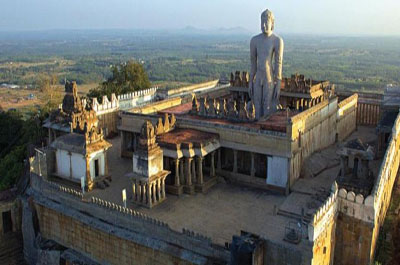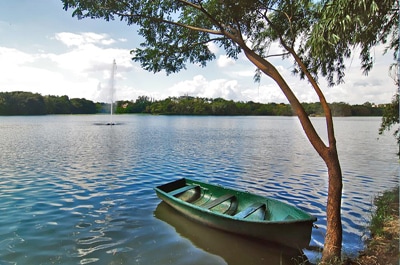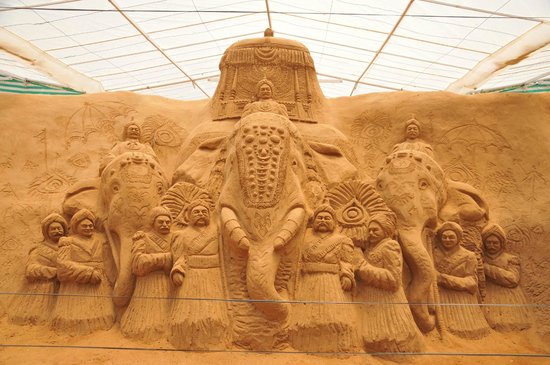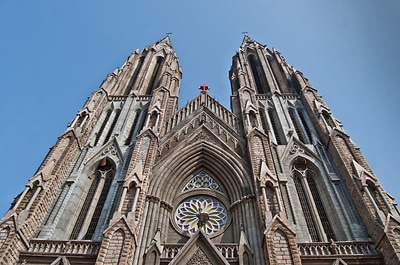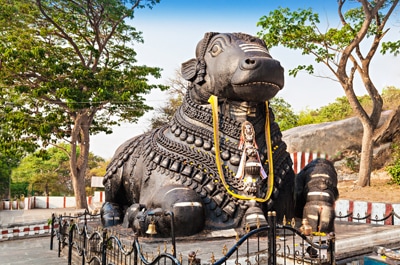Shravanabelagola |
Shravanabelagola is a historical temple town and pilgrimage centre in Karnataka, located in South India. This small town boasts of the largest number of Digambara temples as well as the largest number of inscriptions in the country.The cynosure of the centuries, Gommateshwara towers in his 57 feet solitary serene splendour, over the surrounding countryside. This freestanding monolithic statue, which crowns the 438 feet high present- day Indragiri or Vindhyagiri, hewn out of granite is the largest of its kind in the world. Majority scholastic opinion dates its consecration by Chavundaraya, a general of the Ganga dynasty, to 981 A.D. He was inspired by his mother Kalala Devi. The statue was executed in 12 years by Mahashilpi Arishtanemi. Earlier Indragiri, with 647 steps, was called ‘Per-Kalbappu’ (Large-Kalbappu) or Dodda Betta. There are 7 types of monuments – eight small and large temples, four mantaps, two ponds, five gateways or fortresses, three pillars, two arches and 172 inscriptions. These, in Kannada, Sanskrti, Marvadi Mahajani, Tamil and Marathi, date from the late 10th to 19th cent A.D.
|
Karanji lake |
Karanji Lake (Kannada: ಕಾರಂಜಿ ಕೆರೆ) is a lake located in the city of Mysore in the state of Karnataka, India. The lake is surrounded by a nature park consisting of a butterfly park and a walk-through aviary.[1] This aviary is the biggest 'walk-through aviary' in India.[2] There is also a museum, the Regional Museum of Natural History which is located on the banks of this lake. The total area of Karanji lake is 90 hectares. While waterspread area is about 55 hectares, the foreshore area measures about 35 hectares.[3] Karanji lake is owned by the Mysore Zoo Authority.[4] Mysore Zoo gets a revenue of an average of Rs. 50000 per day from ticket sales to enthusiasts who visit this lake Kar barouanji Lake was one of the favourite haunts of migratory birds like herons and egrets. But the lake started getting polluted when sewage from the nearby residential areas were let into the lake. This pollution led to the destruction of aquatic life in the lake and with the food-source getting depleted, the migratory birds started to avoid the lake.
|
Sand sculpture museum |
Mysore Sand Sculpture Museum is India’s first sand sculpture museum and is located in Mysore, close to the Chamundi Hills. The museum is spread over an area of about 13,500 square feet and was created by M N Gowri, who has a Bachelor in Fine Arts and who wanted to show something unique to the tourists. You will be taken to another world where these magnificent pieces of art have been made with the use of only sand of water. There are over 150 sculptures that are exhibited here. It is amazing how a temporary sand sculpture you make on beaches is made permanently to stay here at this museum. The most prominent themes visible are the heritage of Mysore, scenes from epic mythological stories, wildlife, and religions around the globe. A giant sculpture of Lord Ganesha welcomes you right at the entrance of the museum. With an entry fee of just Rs. 40, this is a fine recommendation while you’re touring Mysore. It is most convenient to take a taxi from your accommodation at Mysore. You could also use the bus. The nearest railway station is the Mysore Railway Station, 5.6 km away.
|
St. Philomena's Church |
St. Philomena's Cathedral is a Catholic church that is the cathedral of the and the Diocese of Mysore, India. The full name is the Cathedral of St. Joseph and St. Philomena. It is also known as St. Joseph's Cathedral. It was constructed in 1936 using a Neo Gothic style and its architecture was inspired by the Cologne Cathedral in Germany. This is one of the tallest churches in Asia.St. Philomena is a Latin Catholic saint and martyr of the Roman Catholic Church. She was a young Greek princess martyred in the 4th century. The remains of a teenage girl no older than 14 were discovered on May 24, 1802 in the Catacombs of Saint Priscilla at the Via Salaria in Rome. Accompanying these remains were a set of tiles bearing a fragmented inscription containing the words LUMENA PAXTE CUM FI, words of no known meaning in that order. The letters were rearranged to read PAX TECUM FILUMENA, which in Latin translates to Peace with you, Filumena. also some symbols of her martyrdom and a vessel, containing dry blood, was also found in the tomb. From these discoveries, it was concluded that a Christian named Filumena (Philomena) was buried in the tomb and the vessel containing blood was thought to be her relic, an evidence of a martyr's death.
|
Bull Statue |
This giant image of Nandi (Bull) is located at the top of Chamundi hills in Mysore. More than 350 years old, this is one of the oldest icons in Mysore. According to Hindu mythology Nandi is considered as the vehicle (mount) of Lord Shiva, the lord of destruction. In front of every Shiva temple, on the court facing the shrine, you can see the image of a Nandi. About 16 feet in height and 24 feet long, this Nandi atop the Chamundi Hills is the third largest in India. The creation of this colossal image is attributed to Dodda Devaraja Wodeyar (1659–1673) on of the illustrious Maharajas of Mysore. It is the same maharaja who also commissioned the 1000 stepped stairway to the hilltop.
Originally this was a colossal boulder. The image of the Nandi was carved out of this boulder in situ. When you visit this Nandi just look around to see similar boulders around this site. In fact right behind the Nandi image is small cave temple under an overhanging boulder dedicated to Shiva. These boulders are painted with white and ochre stripes. |
